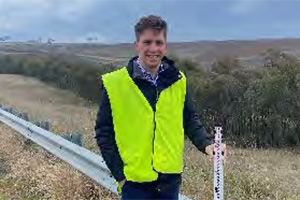Sustainability
- Home
- Locations
- What you can do
- LiFE Framework
- Sustainable Development Goals
- About us
- Grants
- Events
- Contact us
Now searching for:

Charles Sturt Engineering student, William Douglas, in the field while on placement with Blayney Shire Council
Charles Sturt University offers an innovative engineering program designed to deliver entrepreneurial engineers equipped to face the challenges of the future and fill crucial skills gaps in regional Australia.
The program was established in 2016 and was designed to feature workplace learning at its core. Students undertake a minimum of 6,000 hours of workplace learning delivered via four
one-year paid work placements. During this phase of the program, technical content is delivered online through a learning approach known as the Charles Sturt Engineering topic tree. The topic tree delivers small sections, or topics, of content three hours at a time.
Charles Sturt University researchers Dr Karthika Krishna Pillai, Dr Jim Morgan and Dr Lala Senevirathna evaluated the workplace learning model and discovered that the model has successfully adapted to disruptions caused by the COVID-19 pandemic. COVID-19 greatly disrupted traditional delivery of education and training, they reported, and had impacts on equity, diversity and inclusion for engineering students worldwide.
However, the evaluation concluded that, due to its program design, our Engineering program operated smoothly with minimum disruptions.
Engineering students as early as their second year undertake workplace learning via cadetships within local regional organisations. Regional NSW is experiencing increased infrastructure investment and growth; as a result skilled engineers are crucial for sustainable growth.
Cadet hosts such as Blayney Shire Council recognise the importance of the workplace learning focus of the program. “The Charles Sturt University Engineering program being delivered in a regional city is incredibly important to local government,” says Director of Infrastructure Services at Blayney Shire Council, Mr Grant Baker. “We continue to deliver an increasing infrastructure program, but are challenged by identifying suitably experienced people to manage the works… the development of young, regionally-based engineers will help fill this gap.”
Find out more about
Engineering curriculum to train next generation water engineers